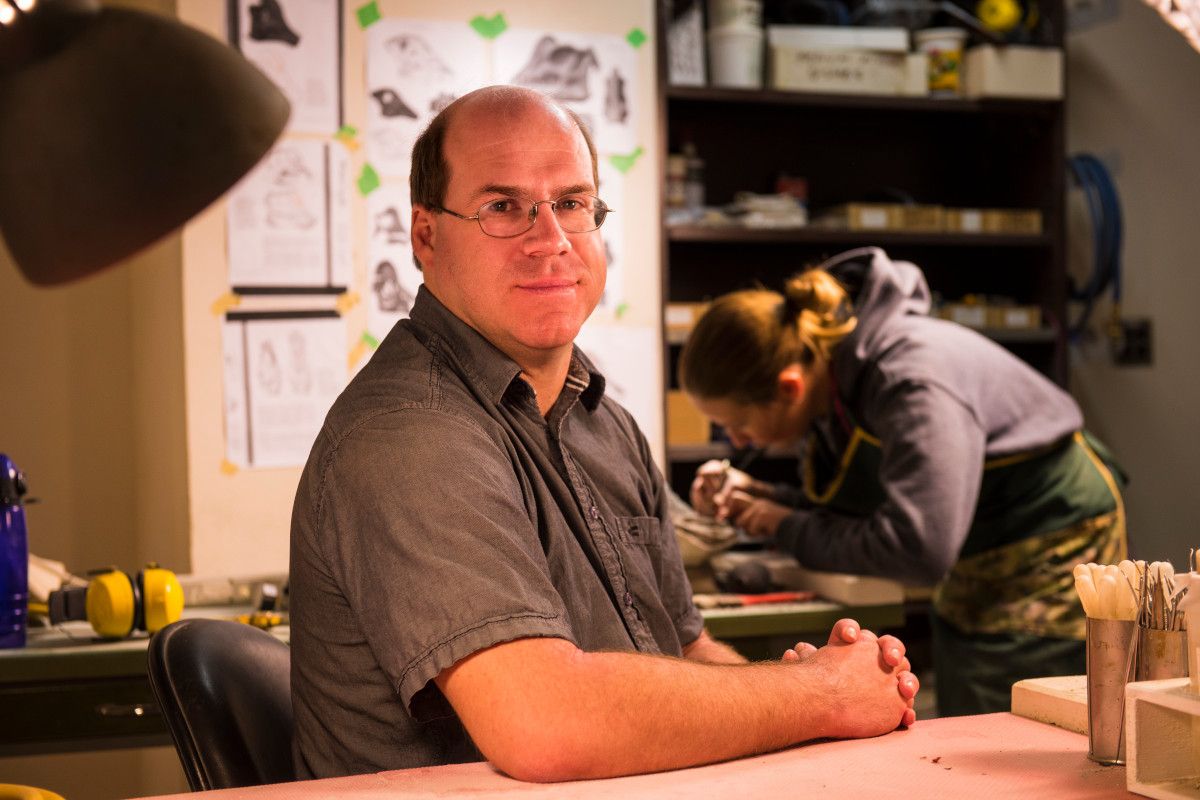
UAlberta paleontologist Corwin Sullivan is host of a new webinar exploring what fossils in Northern Alberta can tell us about dinosaur distribution. Sullivan is pictured here in the lab with biological technologist Robin Sissons. Photo credit: John Ulan
Most Albertans are familiar with the world-renowned dinosaur fossils from our home province. The rich paleontological record that is a point of local pride is helping piece together the picture of how dinosaurs were distributed and evolved throughout ancient North America, explained in a webinar by University of Alberta paleontologist Corwin Sulivan.
“From a fossil perspective, Alberta has everything from ancient fish and invertebrates to Ice Age mammals.” said Sullivan, associate professor in the Department of Biological Sciences, who holds the Philip J. Currie Professorship In Vertebrate Palaeontology and is curator of the Philip J. Currie Dinosaur Museum in Grande Prairie, Alberta. “But the crown jewel is the Alberta dinosaur record, which boasts an excellent quality of preservation and many species—about 50 in DInosaur Provincial Park alone.”
North America was a very different place in the Cretaceous Period of Earth's history, late in the age of dinosaurs. As home to some of the richest Cretaceous dinosaur beds in the world, Alberta has long been central to our understanding of Cretaceous ecosystems, Sullivan said, but until quite recently, paleontologists concentrated overwhelmingly on the southern part of the province.
“The badlands in Southern Alberta are a convenient hunting ground for paleontologists, with lots of bare rock and minimal vegetation,” he explained. “Northern Alberta is more heavily forested, where patches of bare outcrop are few and far between, usually restricted to along rivers.”
But while access to fossils in Northern Alberta comes with unique challenges, the fossil record in the area offers a unique window into the past, one that’s helping paleontologists reconstruct what ancient North America looked like.
“One thing that makes the northern Alberta fossil record unique and notable is the fact that it preserves dinosaurs that lived at a relatively high latitude in the Late Cretaceous,” explained Sullivan. “Northern Alberta remained high and dry at a time of high sea levels, when Southern Alberta was underwater and dinosaurs simply couldn't live there, so the Northern Alberta record preserves valuable information about life on land during that particular time.”
So what sorts of creatures wandered the land of what would come to be Northern Alberta? In his presentation, Sullivan explained one of the iconic finds in the area, Pachyrhinosaurus lakustai, a ceratops that has only been found in the Pipestone Creek Bonebed. And in the Spring Creek Bonebed, the team has been collecting the disarticulated remains of a group of juvenile hadrosaurid dinosaurs.
“The biggest highlight of the work that my collaborators and I are doing in the Grande Prairie area is probably our ongoing excavation of the DC Bonebed, an exciting fossil site that preserves a mix of bones and teeth from many small vertebrates including fish, mammals, turtles, small dinosaurs, and more,” said Sullivan.
“It's a really interesting window into the diversity of smaller animals that inhabited the Grande Prairie area in the Late Cretaceous. We enjoy the challenge of doing riverside palaeontology in the Wapiti Formation and helping to fill in an important corner of the map of Cretaceous life in Alberta.”
If you couldn’t make it to the live webinar, watch the full recording to hear from Sullivan on the dinosaurs and other Cretaceous vertebrates of Northern Alberta.
Visit our calendar to find information on similar events, including live talks and webinars, or check out the Office of Alumni Relations’ On Demand offerings.
Want to learn more about dinosaurs and other science topics? We also offer many free Massive Open Online Courses (MOOCs) to keep you learning and engaged, like Astro 101, Bugs 101, Dino 101, and Mountains 101. For information on how these courses align with Alberta’s K-12 curriculum, please see this useful guide.